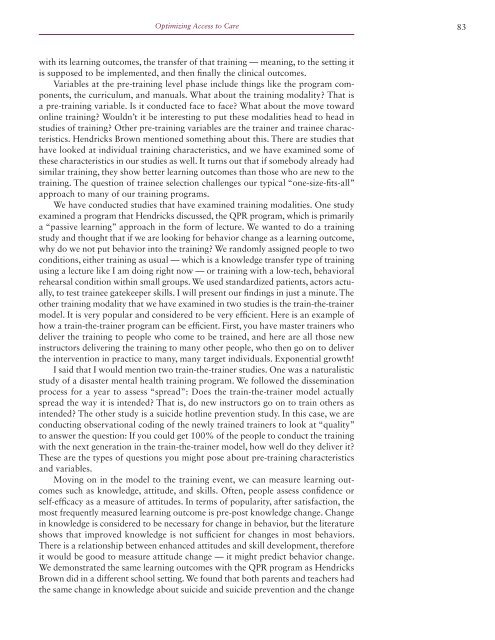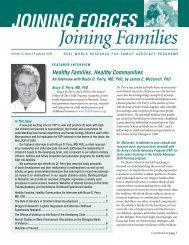stigma and barriers to care - Uniformed Services University of the ...
stigma and barriers to care - Uniformed Services University of the ...
stigma and barriers to care - Uniformed Services University of the ...
Create successful ePaper yourself
Turn your PDF publications into a flip-book with our unique Google optimized e-Paper software.
Optimizing Access <strong>to</strong> Care 83<br />
with its learning outcomes, <strong>the</strong> transfer <strong>of</strong> that training — meaning, <strong>to</strong> <strong>the</strong> setting it<br />
is supposed <strong>to</strong> be implemented, <strong>and</strong> <strong>the</strong>n finally <strong>the</strong> clinical outcomes.<br />
Variables at <strong>the</strong> pre-training level phase include things like <strong>the</strong> program components,<br />
<strong>the</strong> curriculum, <strong>and</strong> manuals. What about <strong>the</strong> training modality That is<br />
a pre-training variable. Is it conducted face <strong>to</strong> face What about <strong>the</strong> move <strong>to</strong>ward<br />
online training Wouldn’t it be interesting <strong>to</strong> put <strong>the</strong>se modalities head <strong>to</strong> head in<br />
studies <strong>of</strong> training O<strong>the</strong>r pre-training variables are <strong>the</strong> trainer <strong>and</strong> trainee characteristics.<br />
Hendricks Brown mentioned something about this. There are studies that<br />
have looked at individual training char acteristics, <strong>and</strong> we have examined some <strong>of</strong><br />
<strong>the</strong>se characteristics in our studies as well. It turns out that if somebody already had<br />
similar training, <strong>the</strong>y show better learning outcomes than those who are new <strong>to</strong> <strong>the</strong><br />
training. The question <strong>of</strong> trainee selection challenges our typical “one-size-fits-all”<br />
approach <strong>to</strong> many <strong>of</strong> our training programs.<br />
We have conducted studies that have examined training modalities. One study<br />
examined a program that Hendricks discussed, <strong>the</strong> QPR program, which is primarily<br />
a “passive learning” approach in <strong>the</strong> form <strong>of</strong> lecture. We wanted <strong>to</strong> do a training<br />
study <strong>and</strong> thought that if we are looking for behavior change as a learning outcome,<br />
why do we not put behavior in<strong>to</strong> <strong>the</strong> training We r<strong>and</strong>omly assigned people <strong>to</strong> two<br />
conditions, ei<strong>the</strong>r training as usual — which is a knowledge transfer type <strong>of</strong> training<br />
using a lecture like I am doing right now — or training with a low-tech, behavioral<br />
rehearsal condition within small groups. We used st<strong>and</strong>ardized patients, ac<strong>to</strong>rs actually,<br />
<strong>to</strong> test trainee gatekeeper skills. I will present our findings in just a minute. The<br />
o<strong>the</strong>r training modality that we have examined in two studies is <strong>the</strong> train-<strong>the</strong>-trainer<br />
model. It is very popular <strong>and</strong> considered <strong>to</strong> be very efficient. Here is an example <strong>of</strong><br />
how a train-<strong>the</strong>-trainer program can be efficient. First, you have master trainers who<br />
deliver <strong>the</strong> training <strong>to</strong> people who come <strong>to</strong> be trained, <strong>and</strong> here are all those new<br />
instruc<strong>to</strong>rs delivering <strong>the</strong> training <strong>to</strong> many o<strong>the</strong>r people, who <strong>the</strong>n go on <strong>to</strong> deliver<br />
<strong>the</strong> intervention in practice <strong>to</strong> many, many target individuals. Exponential growth!<br />
I said that I would mention two train-<strong>the</strong>-trainer studies. One was a naturalistic<br />
study <strong>of</strong> a disaster mental health training program. We followed <strong>the</strong> dissemination<br />
process for a year <strong>to</strong> assess “spread”: Does <strong>the</strong> train-<strong>the</strong>-trainer model actually<br />
spread <strong>the</strong> way it is intended That is, do new instruc<strong>to</strong>rs go on <strong>to</strong> train o<strong>the</strong>rs as<br />
intended The o<strong>the</strong>r study is a suicide hotline prevention study. In this case, we are<br />
conducting observational coding <strong>of</strong> <strong>the</strong> newly trained trainers <strong>to</strong> look at “quality”<br />
<strong>to</strong> answer <strong>the</strong> question: If you could get 100% <strong>of</strong> <strong>the</strong> people <strong>to</strong> conduct <strong>the</strong> training<br />
with <strong>the</strong> next generation in <strong>the</strong> train-<strong>the</strong>-trainer model, how well do <strong>the</strong>y deliver it<br />
These are <strong>the</strong> types <strong>of</strong> questions you might pose about pre-training characteristics<br />
<strong>and</strong> variables.<br />
Moving on in <strong>the</strong> model <strong>to</strong> <strong>the</strong> training event, we can measure learning outcomes<br />
such as knowledge, attitude, <strong>and</strong> skills. Often, people assess confidence or<br />
self-efficacy as a measure <strong>of</strong> attitudes. In terms <strong>of</strong> popularity, after satisfaction, <strong>the</strong><br />
most frequently measured learning outcome is pre-post knowledge change. Change<br />
in knowledge is considered <strong>to</strong> be necessary for change in behav ior, but <strong>the</strong> literature<br />
shows that improved knowledge is not sufficient for changes in most behaviors.<br />
There is a relationship between enhanced attitudes <strong>and</strong> skill development, <strong>the</strong>refore<br />
it would be good <strong>to</strong> measure attitude change — it might predict behavior change.<br />
We demonstrated <strong>the</strong> same learning outcomes with <strong>the</strong> QPR program as Hendricks<br />
Brown did in a different school setting. We found that both parents <strong>and</strong> teachers had<br />
<strong>the</strong> same change in knowledge about suicide <strong>and</strong> suicide prevention <strong>and</strong> <strong>the</strong> change




